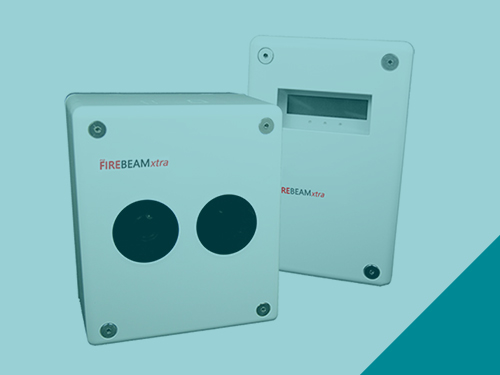Beam detectors are for internal use only, and are the perfect solution for large, open area buildings such as warehouses, shopping malls, libraries and school halls. This is because for the coverage of a large space like these, it is less cost-effective to use point detection devices such as standard smoke or heat detectors, as more of these devices are needed to cover and protect the whole area from fire. Additionally, these environments tend to have high ceilings and hard to reach areas, meaning that beam detectors are a much more suitable option, as it is easier to put them at opposite ends of the room than install and cable several smoke and heat detectors.
As well as being easier and quicker to install in large spaces than point detectors, beam detectors can also be installed at greater heights than smoke detectors. A smoke detector can only be installed up to heights of 10 metres, while beam detectors can be placed much higher at up to 40 metres.
Certain models, like the Hochiki FIREBEAM Xtra also come with a low-level controller. Using wires that come down from the detector to a low-level box, these controllers display all the relevant data coming from the detector. As a result, instead of having to climb up 40 metres to the detector level, building managers can commission, monitor and maintain the device using the low-level controllers at eye level. For areas where there may be children present, such as school halls, low-level controllers can be placed out of their reach, but still remain easy to get to for adults, allowing for easy-access but avoiding the risk of unwanted tampering.
Hochiki Europe’s FIREBEAM Xtra comes fully fitted with a powered output module (POM) meaning there is no need to buy additional power supplies and it can be interfaced directly with the beam detector. The device is fully compatible with our world-renowned ESP analogue addressable protocol and although the standard detection range is up to 70m. Extension kits are available to increase this to 160m. The unit’s newly designed optics also increase sensitivity, while the enhanced internal software reduces false alarms, making the detector ultra-reliable.
Ultimately, for large, open, indoor spaces beam detectors are the perfect life safety solution as they are quick and easy to install and can offer protection in high-ceiling and hard to reach areas when point detectors are unsuitable. Beam detectors with low level controllers make the equipment even easier to use and maintain, and extension kits increase the units’ already long range to provide maximum protection for all your large-environment fire detection needs.
